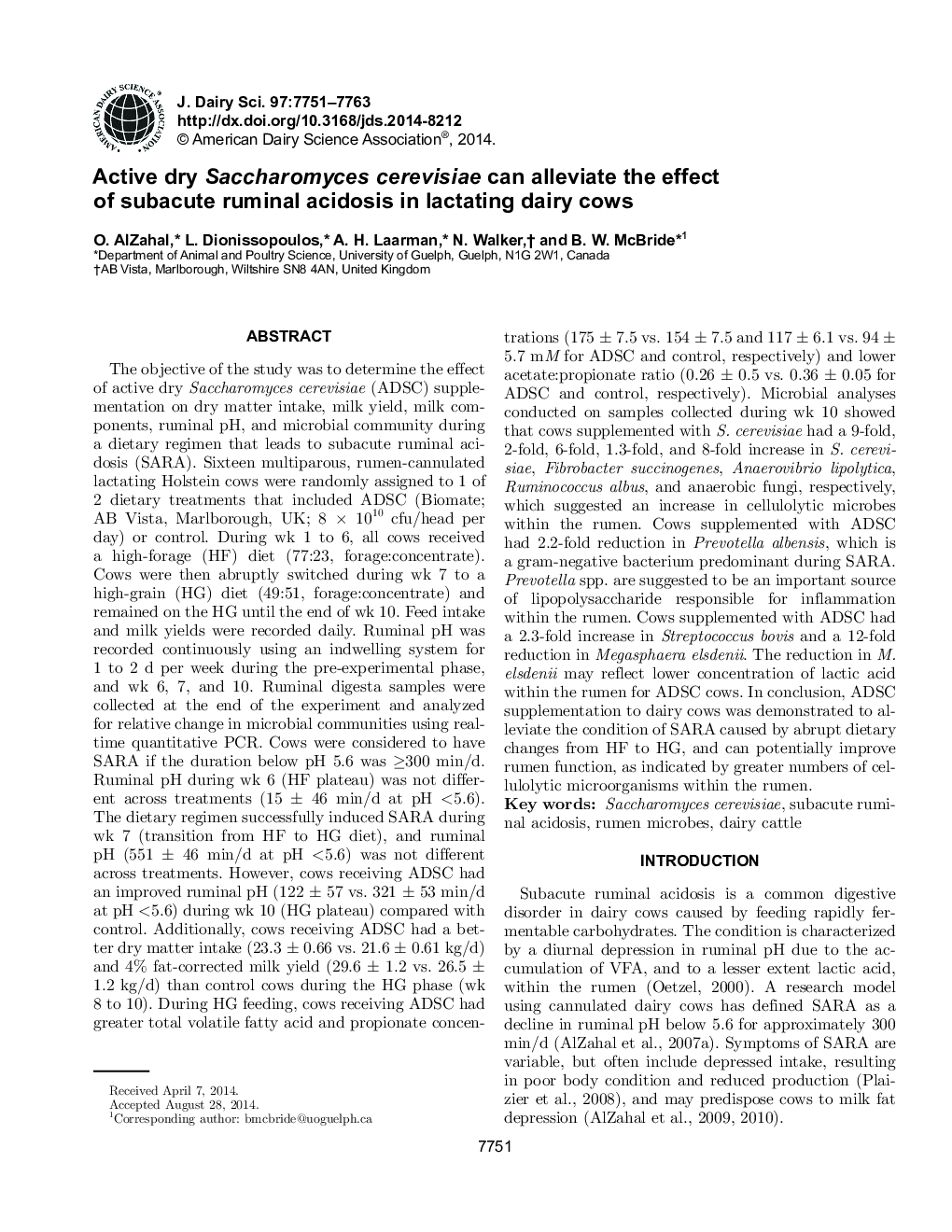| Article ID | Journal | Published Year | Pages | File Type |
|---|---|---|---|---|
| 10973492 | Journal of Dairy Science | 2014 | 13 Pages |
Abstract
The objective of the study was to determine the effect of active dry Saccharomyces cerevisiae (ADSC) supplementation on dry matter intake, milk yield, milk components, ruminal pH, and microbial community during a dietary regimen that leads to subacute ruminal acidosis (SARA). Sixteen multiparous, rumen-cannulated lactating Holstein cows were randomly assigned to 1 of 2 dietary treatments that included ADSC (Biomate; AB Vista, Marlborough, UK; 8 Ã 1010 cfu/head per day) or control. During wk 1 to 6, all cows received a high-forage (HF) diet (77:23, forage:concentrate). Cows were then abruptly switched during wk 7 to a high-grain (HG) diet (49:51, forage:concentrate) and remained on the HG until the end of wk 10. Feed intake and milk yields were recorded daily. Ruminal pH was recorded continuously using an indwelling system for 1 to 2 d per week during the pre-experimental phase, and wk 6, 7, and 10. Ruminal digesta samples were collected at the end of the experiment and analyzed for relative change in microbial communities using real-time quantitative PCR. Cows were considered to have SARA if the duration below pH 5.6 was â¥300 min/d. Ruminal pH during wk 6 (HF plateau) was not different across treatments (15 ± 46 min/d at pH <5.6). The dietary regimen successfully induced SARA during wk 7 (transition from HF to HG diet), and ruminal pH (551 ± 46 min/d at pH <5.6) was not different across treatments. However, cows receiving ADSC had an improved ruminal pH (122 ± 57 vs. 321 ± 53 min/d at pH <5.6) during wk 10 (HG plateau) compared with control. Additionally, cows receiving ADSC had a better dry matter intake (23.3 ± 0.66 vs. 21.6 ± 0.61 kg/d) and 4% fat-corrected milk yield (29.6 ± 1.2 vs. 26.5 ± 1.2 kg/d) than control cows during the HG phase (wk 8 to 10). During HG feeding, cows receiving ADSC had greater total volatile fatty acid and propionate concentrations (175 ± 7.5 vs. 154 ± 7.5 and 117 ± 6.1 vs. 94 ± 5.7 mM for ADSC and control, respectively) and lower acetate:propionate ratio (0.26 ± 0.5 vs. 0.36 ± 0.05 for ADSC and control, respectively). Microbial analyses conducted on samples collected during wk 10 showed that cows supplemented with S. cerevisiae had a 9-fold, 2-fold, 6-fold, 1.3-fold, and 8-fold increase in S. cerevisiae, Fibrobacter succinogenes, Anaerovibrio lipolytica, Ruminococcus albus, and anaerobic fungi, respectively, which suggested an increase in cellulolytic microbes within the rumen. Cows supplemented with ADSC had 2.2-fold reduction in Prevotella albensis, which is a gram-negative bacterium predominant during SARA. Prevotella spp. are suggested to be an important source of lipopolysaccharide responsible for inflammation within the rumen. Cows supplemented with ADSC had a 2.3-fold increase in Streptococcus bovis and a 12-fold reduction in Megasphaera elsdenii. The reduction in M. elsdenii may reflect lower concentration of lactic acid within the rumen for ADSC cows. In conclusion, ADSC supplementation to dairy cows was demonstrated to alleviate the condition of SARA caused by abrupt dietary changes from HF to HG, and can potentially improve rumen function, as indicated by greater numbers of cellulolytic microorganisms within the rumen.
Related Topics
Life Sciences
Agricultural and Biological Sciences
Animal Science and Zoology
Authors
O. AlZahal, L. Dionissopoulos, A.H. Laarman, N. Walker, B.W. McBride,
